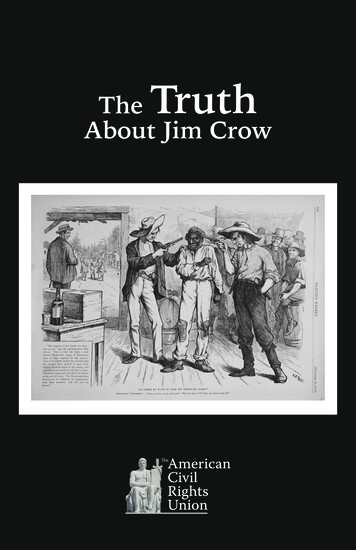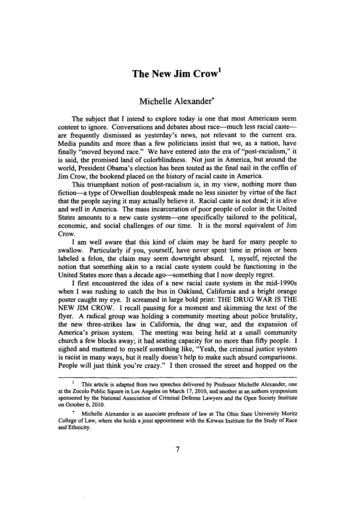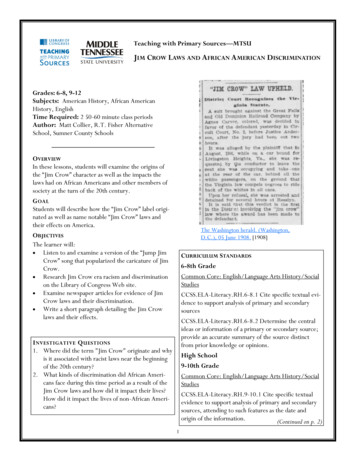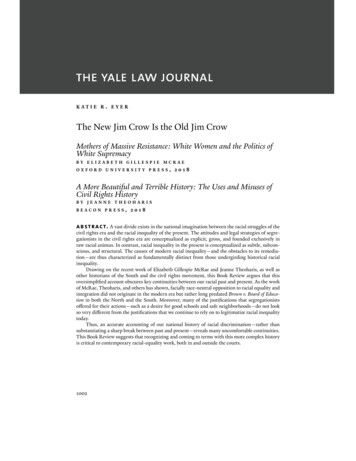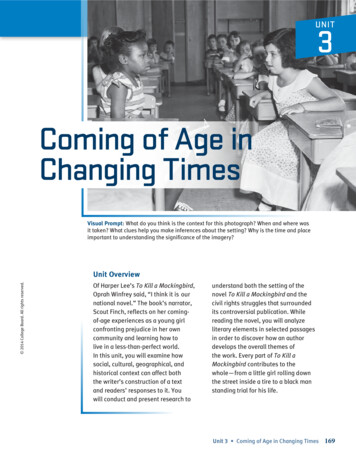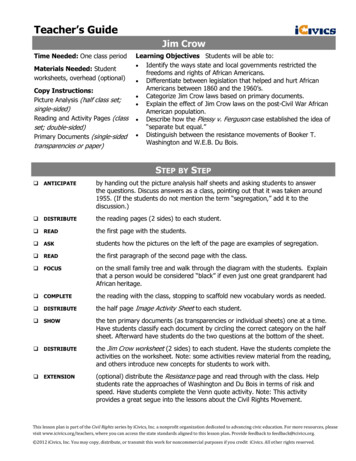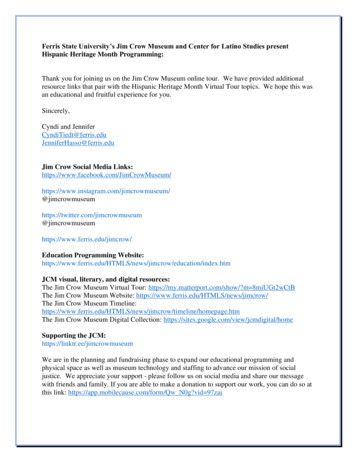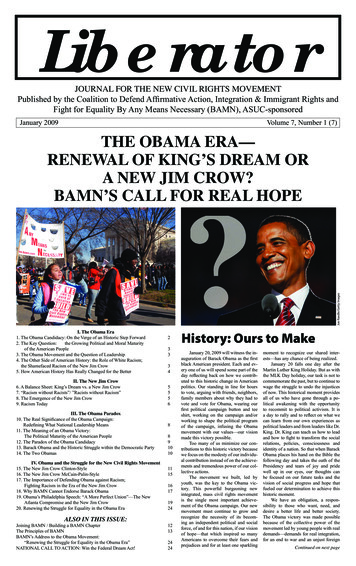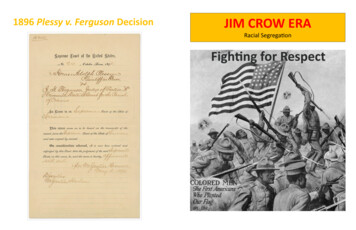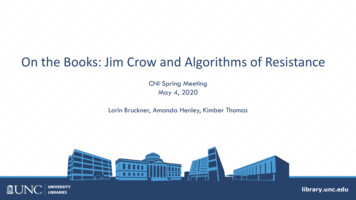
Transcription
On the Books: Jim Crow and Algorithms of ResistanceCNI Spring MeetingMay 4, 2020Lorin Bruckner, Amanda Henley, Kimber Thomas
Jim Crow Codified system of racial apartheid This project uncovers some of the many laws that were put in place tomaintain racial segregation in the U.S. South between 1865-1968. The laws uncovered here demonstrate how, for African Americans,especially, Jim Crow affected nearly every aspect of their daily lives,including attacks on their freedom and dignity.
Figure 2. Outside Looking In, Mobile, Alabama. Adapted from the Gordon Parks Foundation website, retrieved from www.gordonparksfoundation.org. Copyright 1956.
Motivated by a reference question:On the BooksWhere do I find a list of NC Jim Crow laws?
About On the BooksProject to make North Carolinalegal history accessible as a textcorpus.100 years of North Carolina public,private, and local session lawsProject Goals:-Create corpus of NC Session Laws from1865/66-Identify discoverable NC segregationstatutes during the Jim Crow era usingtext analysis
Figure 1. Murray, Pauli, 1910-1985.Adapted from The Carolina Story: A Virtual Museum of University History digital collection, retrieved from The University of North Carolina at Chapel Hill University Libraries website.
Identifying Laws Reviewed 900 laws Laws were separated into two categories: yes or no Laws identified as "yes," or Jim Crow laws, presented evidence oflegalizing or enforcing racial segregation Laws identified as "no," or non-Jim Crow laws, presented no evidenceof legalizing or enforcing racial segregation
Example "No"A photo takes up the entire slide here plus a caption in the top left
Example "Yes"A photo takes up the entire slide here plus a caption in the top left
Expertise Needed Scholarly expertise Deep knowledge of the collection Project management Technical/data skills Programming skills Version control OCR Text analysis Metadata Software development Cross-departmental collaboration fostered through a Special Collections Digital ScholarshipWorking Group
Project TeamNeil Byers, Graduate Assistant – Documentation and Content DeveloperStudent WorkersLorin Bruckner, Data Visualization Services Librarian - Text Analysis andVisualization ExpertMontana Eck, Julia Long, Ashley Mullikin, Siri Nallaparaju, TimOyeleke, and Jenna PattonSarah Carrier, North Carolina Research and Instructional Librarian - SpecialCollections ExpertRucha Dalwadi, Research Assistant - Documentation and Content DeveloperMaría R. Estorino, AUL for Special Collections & Director of the Wilson Library Executive Sponsor and Liaison to the Library Leadership TeamAmanda Henley, Head of Digital Research Services - Principal Investigator andProject LeadMatt Jansen, Data Analyst - Text Analysis Expert and StatisticianWilliam Sturkey, Faculty Member of History - Disciplinary ScholarKimber Thomas, African American Studies ScholarNathan Kelber, Ithaka – Collaborator (former PI and Project Lead)Additional Project Consultants and CollaboratorsDaniel Anderson, Professor for Pilot Project: NC Jim CrowLaws, 1899-1919Ryan Cordell, OCR Specialist and author of A ResearchAgenda for Historical and Multilingual Optical CharacterRecognitionKristen Foote, Research Assistant and Lead for Pilot Project:NC Jim Crow Laws, 1899-1919Anna Goslen, Metadata LibrarianAaron S. Kirschenfeld, NC Legal Information ExpertRichard Paschal, NC Legal ScholarSteve Segedy, Software DeveloperRyan Shaw, Information Science Expert
Workflow and Processes
Compiled comprehensive listing of volumes for our corpusA photo takes up the entire slide here plus a caption in the top left96 volumes in our corpus. Volumes span from 1865/66 – 1967.Gathered OPAC record unique IDs linked to Internet Archive Objects generated download links with Internet Archive API.
ImageChallengesMarginaliaDifferencesbetween volumesImage Skew
ImagepreprocessingMarginalia removed withcustom Python ScriptImages rotatedblank, color-balancedmargins added back tothe images to improveOCR
OCROCR’d over 80,000 pages for the corpus
Devised Metadata Schema XMLConsulted metadatalibrarian to create our ownschema
Corpus creation Text AnalysisCan we determine which laws are Jim Crow?
Challenges Errors in original volumes. Chapter breaks in the margins for some volumesParse/AnnotateLaws(These were split by hand) A few volumes have Roman Numerals (did not OCR well) Numbers OCR poorlyUsing regular expressions to fix common errors.Likely to be the biggest limitation in our corpus.Currently we have over 280,000 sections split.
Text AnalysisSupervised and Unsupervised Machine Learning
Training the model with laws labeled by experts: Pauli Murray Richard PaschalSupervised William Sturkey Kimber Thomas Our training currently set contains 900 laws 100 "Yes", 800 "No" Needs to be better developed
Experimenting with Naïve Bayes andGradient BoosterModels Naïve Bayes performs better with 90%accuracy High accuracy comes from its ability tocorrectly predict laws that are NOT JimCrow Need to continue to develop training setso more Jim Crow laws can be identified
Topic Modeling No annotation or trainingUnsupervised Algorithm detects differences and similaritiesbetween the law texts Laws placed into groups or "topics" based onthose differences
Topic Models(Using Partial Data, 5% Sample)
Deliverables and Next Steps
Outreach and Education Presented to several audiences: Librarians, DigitalHumanists, K-12 Teachers White paperDeliverables Website Corpus of laws available to download as text Planned assessment date: 3 years Corpus will be retained through Carolina DigitalRepository. GitHub code repository Jupyter Notebooks for explaining code
Jupyter Notebook Example
Carolina K-12 to create a curriculum using our deliverables. Seeking additional funding to further our work: Improve law splitting Create search functionality for websiteNext Steps Improve machine learning models, expand analysis Can we classify the Jim Crow laws? Exploratory analysis – are there temporal or geographictrends? Create OER for use in academic classrooms Investigate potential of using our methods to ID Jim Crowlaws from other states.
Why is this happening at the Library?
UNCData ScienceInitiative Will include a new school for data science Libraries will be tasked with supporting data focusededucation and research Collections are becoming data and data are becomingcollections
Thank youReferencesParks, G. [ca. 1956]. Outside Looking In, Mobile, Alabama [Digital image]. Retrieved m.com.prod/image b2b2c0a59e5fdbfc27eb6.jpeg.Copyright 1956 by Gordon Parks.North Carolina Collection Photographic Archives, University of North Carolina at Chapel Hill University Libraries [Digital image]. Retrieved from:https://dc.lib.unc.edu/cdm/ref/collection/vir museum/id/431
Jim Crow Codified system of racial apartheid This project uncovers some of the many laws that were put in place to maintain racial segregation in the U.S. South between 1865-1968. The laws uncovered here demonstrate how, for African Americans, especially, Jim Crow
